Growing indoor plants is the perfect way to liven up your home. This extensive guide will show you everything you need to know so you can easily grow houseplants with success.
I’ll also help you troubleshoot common problems, answer your FAQs, give you tons of information and tips, and so much more!
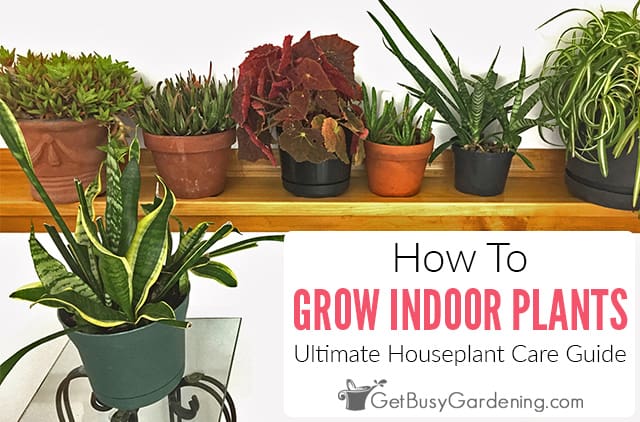
If you want to add some green into your home, or simply liven up the decor, then growing houseplants is perfect for you! It’s fun and addicting, and I absolutely adore my houseplant collection.
I get the love of indoor plants from my mom. She’s always had a ton of houseplants (and still does!). So I grew up surrounded by green, and have been growing indoor plants most of my life.
It’s also one of my favorite topics to write about, and I get great pleasure from sharing my deep knowledge with others.
I’ve poured not only my expertise, but also my heart and soul into this comprehensive guide so that I can share my passion with you.
I want you to be successful with not only keeping houseplants alive, but thriving, so that you can enjoy them as much as I do.
So, if you’re looking for all the answers about how to maintain and grow healthy indoor plants, then you are definitely in the right place!
Growing Plants Indoors
Growing indoor plants is a huge topic, and there’s no way I could cover every intricate detail for each type in one article.
So, use this guide as a starting point for everything you need to know about how to grow healthy houseplants.
If you’re looking for instructions for a specific variety, then check out my tropical houseplant care guide or my indoor succulents care guide to get started.
Or you can visit the houseplant types page to find information about more specific ones.
Also, it’s always a good idea to look up the specific growing requirements for each of your different houseplants, so you know exactly what they need to thrive.
Related Post: The Best Indoor Houseplant Supplies, Tools & Equipment
How To Grow Houseplants
I’m going to let you in on a little secret… the key to growing indoor plants with success is giving them what they want.
Every type of indoor plant has the same basic needs. If these needs aren’t met, then they will start having problems. It really is as simple as that.
But it can be OH SO much harder in practice, right!? Don’t worry, I’m not gonna leave you hanging. In this section, you’ll find ALL the details about the basic houseplant growing requirements.
Watering
Proper watering is one of the most important aspects of growing healthy indoor plants… and it’s also the hardest thing to get right.
Overwatering is the biggest killer of indoor plants, and the most common mistake that newbies make.
Many people think that they need to water all of their houseplants on a schedule, which is their first mistake.
Rather than mindlessly watering your indoor plants based on a set schedule, you should always check first to make sure they actually need it.
While it’s true that most houseplants like to be watered consistently, if you do it on a set schedule, there’s a much higher chance that you’ll end up giving them too much. And consist overwatering will eventually kill them.
Here are a few quick houseplant watering tips to help you out. To learn everything you need to know, read my ultimate guide for how to water indoor plants.
- As a general rule of thumb, allow the soil to dry slightly between waterings. Then give your houseplant a good soaking until water starts to run out of the bottom of the pot. Be sure to empty the drainage tray, and never leave them soaking in water.
- Check indoor plants weekly to see if they need water by sticking your finger one inch into the dirt. If you’re feeling unsure, then get yourself a soil moisture gauge so you can give them the perfect amount of water every time.
- The soil should never be soggy, or remain wet for long periods of time. On the flip side, it should never get to the point of being bone dry either.
- Rainwater or distilled water are the best types to use. Tap water contains salts and chemicals that can build up in the soil, and damage sensitive houseplants.
Humidity
Most indoor plants are originally from tropical climates, so they love humidity. That’s why they thrive when you put them outside during the summer!
That is also one of the main reasons why it can be such a struggle to keep them thriving once you bring them back indoors for the winter.
Heating our homes sucks the humidity right out of the air, which means our moisture-loving houseplants will start to suffer.
One of the telltale signs that there’s not enough humidity for indoor plants is brown leaf tips and edges. A humidity monitor is a great tool to have to see how dry the air is.
To simulate the natural humid environment that they crave, try misting the leaves periodically. You can also use a cool-mist humidifier, or grow finicky houseplants in a mini-indoor greenhouse.
Light
Most houseplants don’t require full sun to grow, and that’s why they do so well inside. But even low-light varieties will start to suffer if they don’t get enough sun.
Sometimes it can take a little bit of trial and error to find the perfect amount of sunlight for each of your houseplants.
So, if you’re unsure about how much sun your houseplant needs, start by placing it in a location that gets indirect bright light.
This is either near a south facing window, where it gets filtered light through a shade, blinds, or a curtain. Or it can be in an east or west facing window.
Then keep an eye on it to see how well it grows there. If it’s happy, leave it there. Otherwise here are a few signs that your houseplant isn’t getting the right amount of sunlight…
- Not enough light – Indoor plants will start reaching for the window, or get leggy, weak, spindly growth when they don’t get enough light. The leaves can also lose their color, or look almost transparent. If this is the case, then move them to a sunny window, or add a grow light.
- Too much light – If the leaves quickly start to look faded, or begin turning white or crispy brown, then they may be getting sunburn. Move them away from the sunny window, and place them in a spot where they will get less light.
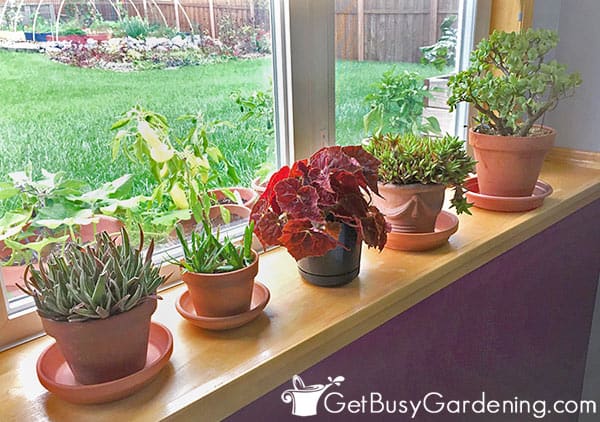
Temperature
The ideal temperature for growing indoor plants is 60-75°F. Also, keep in mind that houseplants don’t like drafts. Extreme hot or cold temperature shifts can cause major damage, or even kill them.
So always be sure to place them far away from heat sources, like vents, radiators, and fireplaces. As well as sources of cold air, like the air conditioner, or cold drafty doors and windows in the winter.
Common symptoms of abrupt temperature shifts are, your houseplant suddenly starts drooping, or the leaves suddenly turn black, white, or crispy brown.
If any of these symptoms occur, check the area to see if a draft or extreme temperature change is to blame.
Related Post: 15 Easy Indoor Plants That Anyone Can Grow
Soil
Houseplants need the right type of soil to grow their best. Never use garden soil, cheap dirt, or outdoor container potting soil for growing indoor plants.
That’s just asking for trouble with bugs, disease, mildew and other yucky things.
Indoor plants usually aren’t fussy about the type of soil they’re growing in. A general purpose potting soil will work just fine in most cases.
However, it’s always best to research the specific type of soil to use for each of your indoor plants.
Some will grow better in a fast-draining sandy soil mix. While others prefer a wood or bark-based medium, or other special growing mix.
If you tend to overwater, or you’re growing indoor plants that don’t like a lot of water, then mix some pumice or perlite into the soil.
On the other hand, if you forget to water, or the soil dries out too quickly, then add vermiculite or peat moss to the soil to help it retain moisture longer.
Repotting
When a houseplant grows in the same container for a long time, it can become pot-bound (or root-bound) and will usually need to be repotted.
Some like to be pot-bound, but most will start to show signs of distress if they stay that way for too long.
You should only repot when it’s necessary. And never repot a sick or unhealthy indoor plant, because the transplant shock could kill it.
Here are some signs that your a houseplant needs to be repotted…
- Roots growing out of the bottom of the pot, or on top of the soil
- The pot looks like it’s about to bust open
- The houseplant is top-heavy and keeps falling over
- Water runs straight out of the bottom of the pot without soaking in
And here are a few quick-tips for repotting. Read my detailed guide to learn all that you to know about how to repot plants.
- Spring is the best time to move your indoor plants into new pots
- Don’t use a container that’s too large, only go up one pot size
- Always use a pot that has drainage holes
- To minimize the risk of transplant shock, water your houseplant a few days before repotting
Also, be sure to give it plenty of time to adjust to the new pot. It’s normal for them to droop a bit after they are repotted, so don’t panic. Just leave it alone and let it recover.

Best Pots For Growing Indoor Plants
There are tons of beautiful decorative pots to choose from, and it’s fun to find the perfect ones to match your home decor.
However, the type of pot you use for growing houseplants could wind up causing some major problems.
The most important thing to think about when shopping for the perfect planter is drainage.
Houseplants need adequate drainage to grow their best. Without it, the chance of watering too much is greatly increased.
So always be sure to use a pot that has holes in the bottom. If you’re worried about the water leaking everywhere, then place them in a deep drip tray or cache pot to capture the excess.
Oh, and putting stuff like packing peanuts, rocks or pebbles into the bottom of one without holes does NOT improve drainage. I’m not sure who started that rumor.
The second most important thing to think about is the material a pot is made out of. I always grow houseplants in either clay or plastic.
Then I use the decorative ceramic planters as cache pots to hide the boring or ugly ones.
- Plastic pots – It’s best to use plastic if you tend to neglect your indoor plants, or forget to water them. Plastic works to hold moisture in the soil longer. These are my favorite plastic pots to use.
- Terracotta clay pots – On the flip side, if you’re notorious for watering too much, then use an unglazed terracotta pot. Clay wicks moisture away from the soil, allowing it to dry out faster, and lowering the risk of overwatering.
Fertilizer
Indoor plants benefit from being fertilized, just like any other plant does. But in general, you should only fertilize them during the spring and summer months.
Most houseplants go into a dormant state during the fall and winter. Feeding them during their dormant period can cause stress, and result in thin, weak, or leggy growth.
I always recommend using organic fertilizers on houseplants, rather than synthetic chemical ones. Many are sensitive to chemicals, and can easily be damaged by overuse.
Plus organic fertilizers work better, and there’s a much lower risk of burning your houseplants.
Over-feeding with synthetic fertilizers is a very common problem. They can burn houseplants, causing brown leaf edges and tips, or even kill them.
I use an organic compost solution, or brew my own using compost tea bags. Other organic products that I like using are this houseplant fertilizer or a general purpose plant food.
Use these liquid-based products to feed your indoor plants every few weeks. Or, if you prefer, you could add a slow-release granular fertilizer into the soil a couple of times throughout the summer, rather than using liquids.
For even more information, you can learn everything you need to know about how to fertilize indoor plants here.

Controlling Houseplant Pests
One of the biggest frustrations with growing houseplants is dealing with bugs. Yes, that’s right, plants growing indoors can get bugs, even if they never go outside. Yuck!
The best way to deal with any type of infestation is to act fast, isolate the affected houseplant(s), and start treating them right away.
Never use chemical insecticides on houseplant pests. These types of bugs can build up an immunity over time, making the problem much worse. Plus chemical pesticides are bad for you, your family, and your pets.
The bugs can be removed by hand, or gently washed off with an organic insecticidal soap. You can also make your own spray by mixing 1 tsp of mild liquid soap with 1 liter of water.
Sticky traps are also very effective. Depending on the bug, you can try either yellow or blue sticky traps to capture flying insects.
I also highly recommend getting yourself some organic neem oil. It’s a natural insecticide that works great to get rid of bugs on indoor plants for the long-term. Horticultural oil is another organic option that you can try.
Whatever you use, just be sure to be consistent. You can’t get rid of any bug infestation in only one or two treatments.
It can take some time, and lots of patience. Learn more about getting rid of bugs on houseplants here.
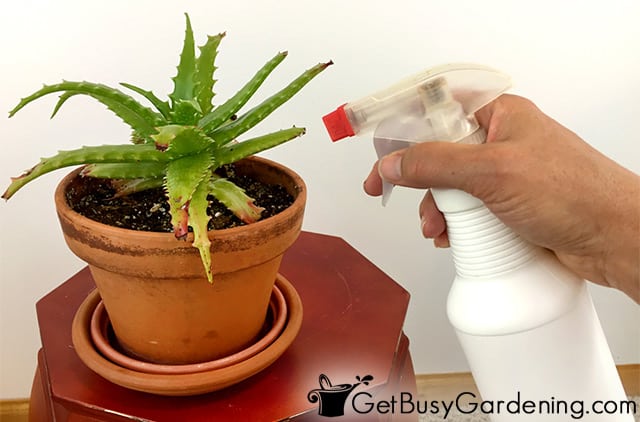
Pruning
To keep your indoor plants looking their best, it’s a good idea to prune them regularly. Not only will it keep them looking tidy, but it can also help to encourage fresh new growth.
You can prune out any dying or dead leaves down to the soil level at any time. Also, trim off brown leaf tips and edges as necessary.
If your houseplant gets flowers, then deadheading them regularly can help to encourage new blooms, and keep them looking nice. Simply cut the dead flower spikes down to the base of the stem.
Growing Flowering Indoor Plants
Some houseplants not only have beautiful foliage, but they flower too. Bonus! Depending on the variety, some will bloom reliably every year, while others will require the perfect growing conditions.
Indoor plants that bloom need slightly different growing conditions than those that do not flower.
First, be sure to give flowering houseplants plenty of light. If yours won’t bloom, then add a grow light, or move it to a brighter location.
Fertilizer is also important for indoor plants to bloom. Feed them during their active growing season, then stop after they are done blooming.
Deadhead or prune out the spent flowers regularly to encourage new ones.
Cleaning Indoor Plants
Dust settles on the leaves of houseplants just like it does on furniture. Cleaning them on a regular basis helps them look better, and stay healthy.
For large leaf indoor plants, use a damp soft cloth to gently wipe the leaves.
You can also bring it outside or into the shower, and rinse the leaves with a gentle spray of water (don’t rinse hairy-surfaced houseplants).
Do not use any type of chemical leaf shine or other types of leaf polishes on your houseplants though. Those products can clog the pores, encourage bug infestations, or just attract more dust.
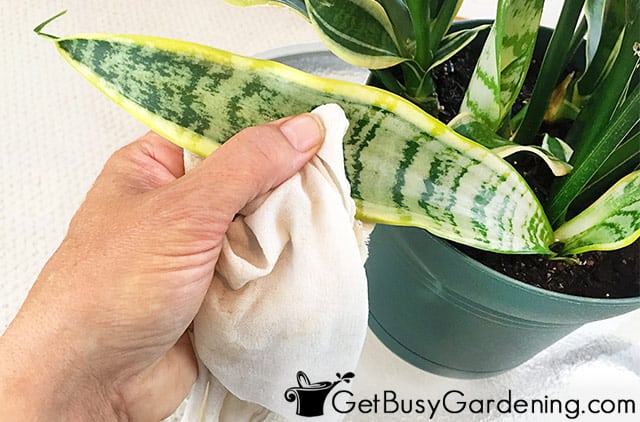
Moving Houseplants
Whether bringing a houseplant home from the store, or moving your entire collection to a new house, transporting them can be dangerous.
When moving them to a new home, they should either be the first thing you transport, or the last. It’s a good idea to move houseplants all at once, so you don’t forget about any of them.
Group them in open boxes to make carrying them easier. Or you can wrap each one completely in paper (not plastic!), then pack them into closed boxes. But don’t leave them in a closed box for more than a few days.
Never leave houseplants sitting in the car either, especially on hot or cold days. It only takes a couple of minutes for them to freeze or fry when left sitting in the car. (ehem, not that I would know anything about that!)
Speaking of frozen houseplants… whenever you need to transport them during the winter, it’s crucial that you cover them completely.
The leaves can freeze instantly if they’re brought outside in the winter. So plan to cover them if it’s below 40F outside.
Propagating Indoor Plants
If you want to expand your houseplant collection, or share your favorites with friends, then try propagating them! There are a few ways to do it, but the easiest are by division or by taking cuttings.
When dividing houseplants, remove the whole thing from the pot, and gently tease apart the roots to separate them.
Just be sure that each stem or baby has its own root system before removing it from the mother plant.
Cuttings can either be rooted in water, or dipped in rooting hormone and placed in soil, depending on the houseplant.
When rooting cuttings in water, be sure to keep the water clean, and top it off as it evaporates.
The key to getting most houseplant cuttings to root in soil is to increase the humidity around the foliage, and keep the soil on the dry side.
Don’t water it too much, or the cutting will only rot. Learn more about plant propagation, and how to get started here.
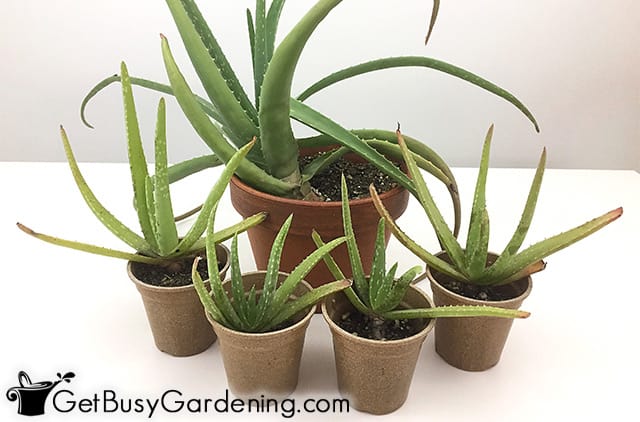
Growing Indoor Plants In Water
Some houseplants can be grown in water, if you want to give that a try. The benefit of doing this is that you don’t have to worry about watering them, or dealing with any annoying bugs in the soil.
Not all indoor plants can be grown in water though, so you’ll have to do your research (or have fun experimenting).
Also, the longer they’re in the water, the harder it will be for them to adjust to growing in soil again.
The key to making this work is to keep the water clean, and the amount consistent. Never allow the water to get low enough for the roots to dry out.
Also, keep an eye on them to make sure the stems aren’t rotting. If that starts to happen, you can prune off the rotting stems, and refresh the water.
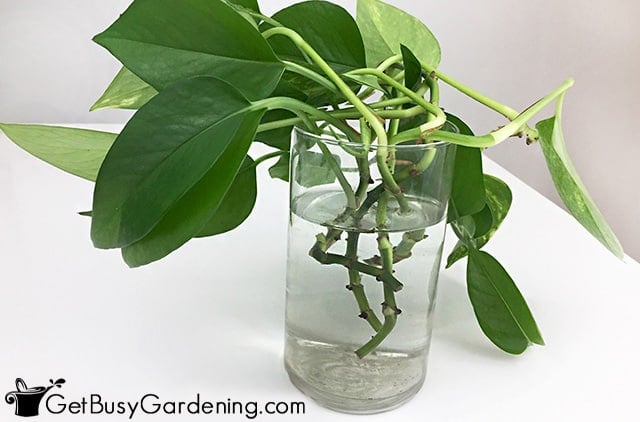
Vacation Care For Houseplants
For the most part, you don’t have to worry about your houseplants when you go on vacation.
Most indoor plants can go a few weeks without water. Just give them a good drink before you leave, and they’ll be fine.
However, if you are going to be on vacation for more than two weeks, or you have finicky houseplants that can’t go very long without water, then you should plan ahead.
Indoor plant watering devices are a great option to automatically water your most delicate houseplants while you’re on vacation.
You can get some cute decorative ones, or use stakes like this with recyclable bottles.
If you use grow lights, simply get an inexpensive outlet timer, and set them on a schedule while you’re away. Easy peasy!
Seasonal Indoor Plant Growing Tips
Your houseplants needs will vary during different times of the year. Even if they aren’t growing outside, they still experience the changing of the seasons.
It’s important to understand how their needs change, so you can keep them thriving all year long. Here are a few seasonal houseplant growing tips.
Winter
Houseplants grow differently in the winter than they do during the summer. Most of them go into a dormant state, and will slow down or stop growing all together.
Winter is the hardest time for growing houseplants, and many can end up suffering, or even dying during the long, dark, and dry winter months.
Here are a few tips to help you get them through the winter. But you should definitely read my detailed post about keeping indoor plants alive in winter here.
- Slow down on watering them, and allow the soil to dry out a bit more
- Stop fertilizing them
- Give them more humidity
- Increase the amount of light, if necessary
- Keep them warm, and away from hot or cold drafts
- Watch out for bugs, winter is their prime breeding season!
Spring
Spring is the official beginning to the growing season for indoor plants. This is when they start waking up from their winter slumber. It’s important to help them through the transition by giving them a little extra TLC.
Below are some quick tips to get them through it without any issues. Learn even more in my spring care guide.
- Repot any that need it
- Increase the amount of water you give them
- Start fertilizing, but only with a weak dose so you don’t shock them
- Get them ready to go outside by opening nearby windows on warm days
- Prune off any weak or dead winter growth
- Clean them by wiping the leaves with a damp rag, or giving them a quick rinse

Summer
Many houseplants love being outside during the summer, where they can bask in the heat and humidity. But even if you don’t put them outside, summer is still the active growing season for indoor plants.
Just be sure you know what type of sun exposure they need before you put them into the full sun. Many indoor plants prefer being in the partial shade or full shade, and will burn if given too much sun.
- Slowly acclimate them to the outdoors to avoid sun and wind damage
- Don’t leave them outside overnight until the temperature is consistently above 60°F
- Increase the amount of water you give them
- Fertilize them on a regular basis
Fall
Fall can be a difficult time for houseplants. Cold temperatures and darker days will tell them that it’s time to start going into dormancy.
Some will adjust to this seasonal change fine, while others will not be very happy about it (and who can blame them!).
Here are some tips to ease the difficult transition from summer to winter. Read my fall care guide for even more details.
- Move them back indoors in the fall before the temps get below 60F
- Be sure to debug them before bringing them back indoors
- Watch out for pest infestations
- Slow down on the amount of water you give them
- Wean them off fertilizer to help reduce the shock of seasonal change
What To Look For When Shopping For Indoor Plants
When shopping for indoor plants, it’s important to look for the healthiest ones possible.
That way, they’ll have a much better chance of surviving the transition to their new home, and you’ll have less headaches trying to keep them thriving.
Here are a few of the most important things to look for before buying a new houseplant…
- Healthy foliage – The leaves should not be faded, discolored, yellow, or brown, and they shouldn’t have any unnatural spots on them.
- Signs of bugs – Look both on and underneath the leaves closely to make sure you don’t see any signs of bugs, eggs, or webbing.
- Soil moisture – Check the soil to make sure it’s not completely saturated, soggy, or dried out to the point where it’s pulling away from the side of the pot. It should be slightly moist, or on the dry side.
- Wilting or drooping – Avoid buying houseplants that are wilting or droopy. This is a sign of improper watering, which can cause it to die shortly after you bring it home – regardless of how well you care for it.
- Extreme legginess – Plants that have weak, spindly growth are more prone to pest problems, and some may never recover from extreme legginess.
Troubleshooting Common Houseplant Problems
There are tons of possible problems you can have with growing houseplants. If an indoor plant starts to look sick or die, then stop what you’re doing and observe it for a little while.
Take some time to think about how you’re caring for it, and where you have it growing.
After observing the houseplant, the problem (or combination of problems) will probably become pretty obvious.
Most common houseplant problems are caused by either improper watering (usually overwatering), incorrect lighting, or over-fertilizing. So think about that as troubleshoot these symptoms…
Yellow Leaves
This is almost always caused by either over or under watering. It could also be due to chemical buildup in the soil from tap water and/or synthetic fertilizer use.
But sometimes yellow leaves are just a normal part of their lifecycle (the oldest leaves will often turn yellow and die).
Drooping Leaves
Drooping is usually caused by improper watering (either too much or not enough), but can be from a sudden change in temperature (too hot or too cold), or transplant shock after repotting.
Brown Leaf Tips Or Margins
Most of the time this is caused by lack of humidity, or a chemical buildup in the soil from using tap water, and/or synthetic fertilizers.
Try adding a humidifier, and/or switch to using rainwater or distilled water.
Brown Leaves
Usually from lack of water, but brown leaves can also be caused by exposure to hot or cold drafts, or sunburn.
But some houseplants naturally shed their oldest leaves, which is a normal part of their growth.
Black Leaves
Most of the time this is due to the leaves freezing. For example, if the leaves froze to a window during the winter, or if the houseplant was accidentally left outside during a hard freeze.
Prune off the black leaves, and protect it from the cold in the future.
Weak, Leggy, Spindly Growth
This is almost always caused by lack of light, but could be over-fertilizing or feeding indoor plants during the fall or winter. Give it more light, and only fertilize during the spring and summer.
Deformed Leaves, Curling Leaves, Or They Won’t Unfurl
All of these problems could be from a pest infestation, over-fertilizing, or under watering. In rare cases, it could be due to some kind of disease.
No Flowers
Most of the time this is due to lack of fertilizer, or not enough light. Houseplants that bloom need a lot of light to produce the flowers.
Move it to a sunny location or add a grow light, and feed it to encourage blooming.
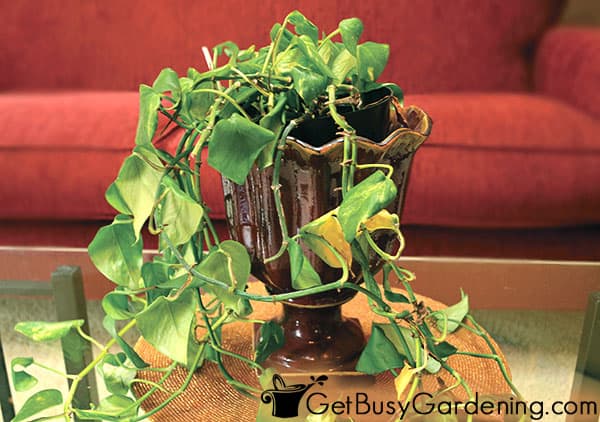
FAQs About Growing Plants Indoors
Below I will answer some of the most commonly asked questions about growing houseplants. If you still have a question after reading through all of this, then ask it in the comments section below. I’ll be happy to answer it as soon as I can.
Why are my indoor plants dying?
I get this question All. The. Time. However, it’s impossible to answer without knowing more details. As I’ve mentioned a few times already, overwatering is the main cause of houseplant death.
However, there’s a whole host of problems that can cause an indoor plant to die. So, start by reading through the “Troubleshooting” section above to see if you can figure it out.
How to you save a dying houseplant?
Again a hard one to give a specific answer to (see the previous question). Take a read through the “Troubleshooting” section above. There you’ll find common problems and their solutions.
Many times it’s just a matter of making a few minor adjustments to your care routine or the growing environment that will save your dying houseplant.
Do indoor plants need sunlight to grow?
All living indoor plants need some kind of light to survive. However, it doesn’t necessarily need to be sunlight. Many will do great under grow lights.
Can houseplants survive without light?
No. There are lots of indoor plants that will grow great in low-light conditions. But there is no such thing as a houseplant that can live without any light.
Growing indoor plants is a fun hobby, and it’s wonderful to have green in your home year-round. The instructions in this guide are a fantastic starting.
The next step is to research the growing requirements for each of your specific houseplants, so you know exactly what they need to thrive.
If you want to learn all there is to know about maintaining healthy indoor plants, then you need my Houseplant Care eBook. It will show you everything you need to know about how to keep every plant in your home thriving. Download your copy now!
More Houseplant Care Posts
- How To Care For Cactus Plants
- How To Make Potting Soil For Indoor Plants
- How To Rebloom Your Amaryllis
- How To Save A Rotting Cactus
- How To Mount A Staghorn Fern (Platycerium) Step By Step
Share your tips for growing indoor plants in the comments section below.
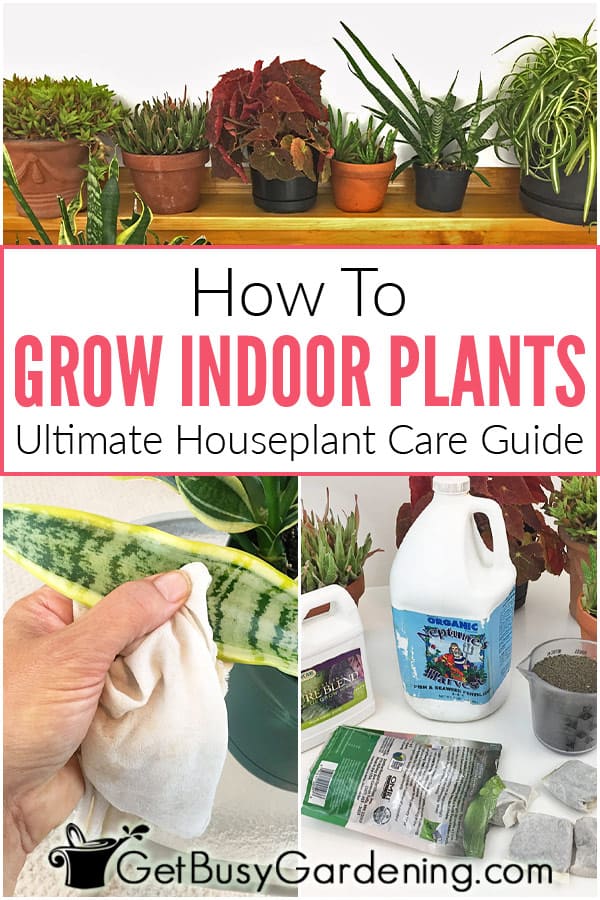
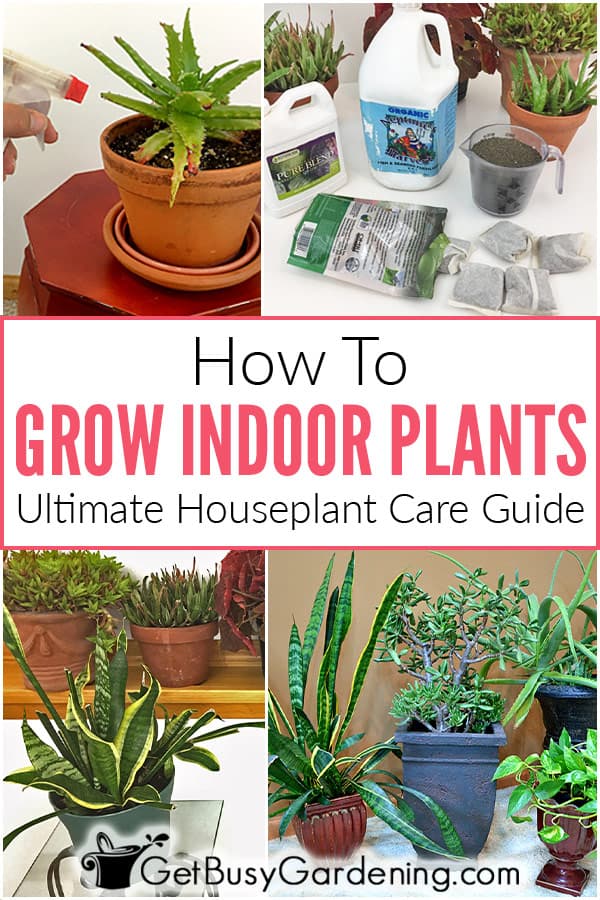
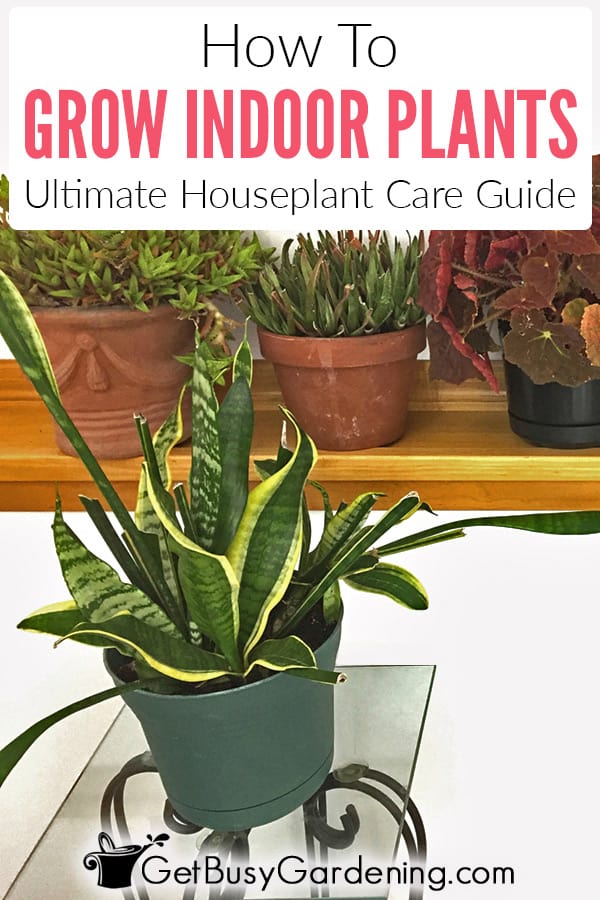



Leave a Reply